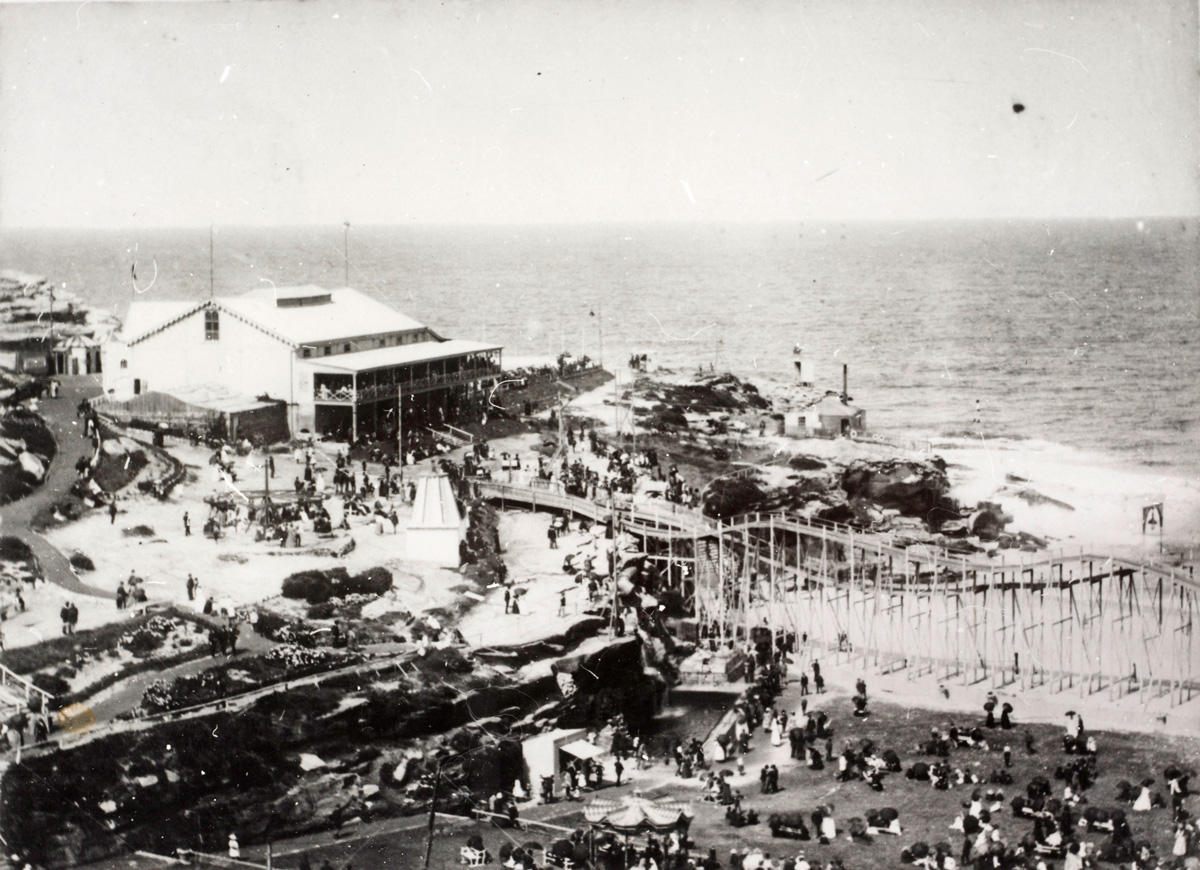
‘Wonderland City’ circa 1900. Bondi Pleasure Park, from Ted Hood collection (photographer unknown)
Tamarama Beach has often been in Sydney’s social and cultural spotlight. In 1887 a Royal Aquarium and Pleasure Grounds was opened on the beach. Commonly known as the Bondi Aquarium, Sydneysiders in their Victorian era finery would visit in their thousands to observe the marine life and enjoy the varied circus and Coney Island styled entertainment. Aside from the sharks, turtles and seals, there was a roller coaster that went from one side of the Tamarama cliffs to the other, Sunday concerts, roller skating rinks “illuminated by the electric light”, fireworks every Wednesday, feats of skill and daring, including the man known as the Australian Blondin, who would walk a tight rope suspended from cliff to cliff.
Visitors would travel to the Bondi Aquarium by tram, walking the last distance from the tram terminus. Destroyed by fire in 1891, the Bondi Aquarium was rebuilt and upgraded at a cost of £7000. The Sydney Morning Herald commented, “Arches of rockwork adorn the front of each of the tanks, and give the aquarium a more pleasant appearance than the straight line of fish tanks that was to be seen in the previous structure”.
Continuing in operation through a number of changes of ownership, the Bondi Aquarium closed in 1906. At this time the site was sold to William Anderson, who by all accounts was an extraordinary man and regarded as the Barnum of Australia, producing theatre and film in cities across Australia and New Zealand. Anderson lavished £20,000 on the site to create ‘Wonderland City’, which opened to acclaim in December 1906. Called a “colossal playground” it attracted an estimated 20,000 visitors on its first night, seriously straining the capacity of the Bondi trams. Wonderland won rave reviews in the Sydney Morning Herald, “it rambles in gorgeous profusion over 20 acres … picturesquely pitched on every coign that lends itself to the dreams of the architect and the accomplishment of the builder, entertainments are housed or rested upon the open ground, their number many and their character diverse … (offering) abundant opportunities for merriment”.
The Daily Telegraph was equally entranced, “Here, indeed, was a new Bondi – a new fairy city… Round an enormous enclosure crept endless lines of lights – tiny bulbs, playing follow the leader up hills and down sandy gullies – and within the enclosure there arose buildings of symmetrical and grotesque shape, brilliantly illuminated against the summer sky. From various points the music of bands swelled or dies as the breeze dictated, and, in harmony with the instruments and the fairy lights, was the long slow rhythm of the waves on the beach below. It was an entrancing picture, a seductive offering to the senses.”
The crowds paid an admission fee to Wonderland City of 6d. for adults and 3d. for children. The main entrance was on Fletcher Street, with a second entrance at the foot of what is now Delview Street. Once inside Wonderland the variety of entertainment was impressive, including a two mile track miniature railway which ran around the cliff tops, a maze, a haunted house, a hall of laughter, a box ball alley, a double decker merry-go-round, a palace of illusions, a wax works, a shooting saloon, challenge boxing matches staged with a prize of £5 to any one who could go a 15 minute round with the strong man.
There was even an airship, which ran across the beach on a solid steel cable, supported at both ends by massive wooden structures attached to the cliffs. Whenever the airship broke down, stopping in midair, the passengers in the basket had to be rescued with the help of an extension ladder.
However, by 1911 Wonderland City had almost financially ruined Anderson with loses estimated at £60,000. The reasons for Wonderland’s failure include battles with local residents and surfers who fought and won to keep the beach between the water and Wonderland a public reserve, charges of cruelty to animals, a not surprising accident on the airship and incredibly bad luck with the weather. It seemed that the more fantastic the extravaganza Anderson planned the worse the weather. As one commentator noted, “there is nothing more desolate than an amusement park beaten and blown by the elements, drenched and bedraggled”.
Written by David Handley with research assistance by Fiona Prior and thanks to Waverley Library. Sources: Daily Telegraph, 3 December, 1906; Sydney Morning Herald, 3 December, 1906; Eastern Suburbs Daily, 19 August, 1924; Sydney Morning Herald, 23 April, 1960; Bondi Surfer, May 1960: ‘This is the Life’, by Claude McKay.